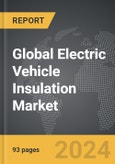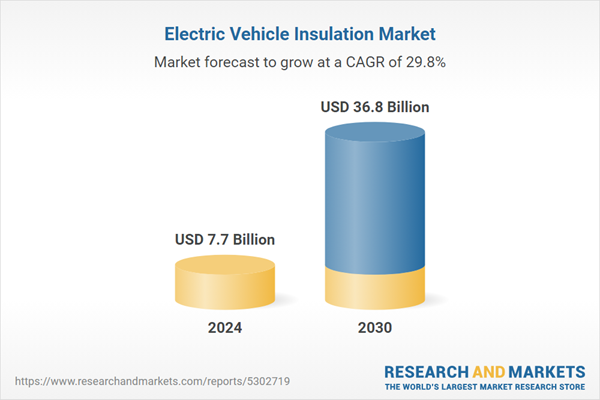Global Electric Vehicle Insulation Market - Key Trends & Drivers Summarized
Why Is Insulation Crucial for Electric Vehicles?
Insulation in electric vehicles (EVs) plays a critical role in ensuring safety, enhancing performance, and improving the overall efficiency of EV components, including battery packs, electric motors, and charging systems. Unlike conventional internal combustion engine (ICE) vehicles, EVs require specialized insulation to manage the high temperatures and electrical loads associated with electric drivetrains. Thermal insulation protects EV batteries from overheating and maintains optimal operating temperatures, which is essential for battery longevity and consistent performance. Electrical insulation, on the other hand, prevents short circuits and reduces electromagnetic interference (EMI), which can impact the performance of sensitive components and in-car electronics. Proper insulation is therefore vital for both the safety and efficiency of electric vehicles, directly influencing reliability and performance.EV insulation also plays a key role in passenger comfort, as it provides noise, vibration, and harshness (NVH) insulation, reducing the sound levels and vibrations caused by the electric drivetrain. As EVs operate quietly, without the usual engine noise, interior insulation for NVH management is increasingly important for a pleasant driving experience. With the continued growth of the EV market, demand for high-quality, lightweight, and multifunctional insulation materials is rising, as manufacturers look for solutions that enhance safety, optimize thermal management, and reduce the vehicle's weight to improve overall efficiency and range.
How Are Technological Advancements Influencing EV Insulation Materials?
Technological advancements are driving innovation in EV insulation materials, making them lighter, more durable, and better suited to the unique demands of electric drivetrains. Lightweight materials such as aerogels, foams, and high-performance plastics are increasingly used in EV insulation to reduce vehicle weight while maintaining thermal and electrical performance. Aerogels, for example, are highly effective insulators with low thermal conductivity and excellent fire resistance, making them ideal for battery insulation. Lightweight materials like these help to extend EV range by reducing the vehicle's overall mass, a critical factor in EV design.Additionally, advancements in phase-change materials (PCMs) are improving thermal management in EVs by absorbing and releasing heat as needed, keeping battery temperatures within the optimal range. With the rise of fast-charging technologies, batteries experience higher heat loads, and materials that provide efficient thermal insulation and rapid cooling are essential. Innovations in electrical insulation materials, such as improved dielectric coatings and high-voltage-resistant polymers, are also critical in protecting EV components from electrical faults and interference. Together, these technological advancements are making EV insulation materials more adaptable and efficient, supporting the growth of the EV market by addressing safety, weight reduction, and thermal management needs.
What Are the Key Applications of Insulation in Electric Vehicles?
Insulation in electric vehicles is applied to various components, each with unique requirements to enhance safety, performance, and comfort. Battery insulation is among the most critical applications, as batteries must be kept within a specific temperature range to ensure longevity and prevent overheating. Insulation materials around the battery pack provide thermal stability and also act as a barrier in the event of a thermal runaway. Motor insulation is another essential area, where materials that can withstand high temperatures and electrical loads are used to protect the electric motor and its winding systems, extending motor life and maintaining efficiency.In addition to these components, insulation is applied to inverters and other high-voltage components to prevent electrical faults and ensure stable operation. The wiring and cable assemblies in EVs also require insulation to handle high-voltage loads safely and reduce electromagnetic interference (EMI). Interior insulation for NVH reduction is also significant, enhancing cabin comfort by reducing road noise and vibrations, an important consideration in EVs, where engine noise is absent. These applications underscore the importance of insulation in EVs, providing comprehensive protection across all critical systems and supporting both safety and performance in various operating conditions.
What Is Driving Growth in the EV Insulation Market?
The growth in the EV insulation market is driven by several factors, including the rising adoption of electric vehicles, advancements in insulation technology, and increasing regulatory focus on EV safety and efficiency. As the global EV market expands, there is a growing demand for effective insulation solutions that address the specific thermal and electrical needs of electric drivetrains. Technological advancements in insulation materials, including lightweight composites, phase-change materials, and fire-resistant coatings, are enabling manufacturers to meet performance and safety requirements without adding excess weight to vehicles. These materials play a crucial role in optimizing thermal management, supporting fast charging, and extending battery life, which are essential for improving overall EV performance.Regulatory pressures for enhanced safety standards in EV design are also boosting demand for high-quality insulation. Governments in regions like North America, Europe, and Asia are implementing stringent safety standards for battery performance and high-voltage systems, prompting automakers to invest in advanced insulation solutions. Additionally, consumer demand for greater driving range and comfort is driving manufacturers to incorporate lightweight and NVH-insulating materials, as they improve both energy efficiency and passenger experience. Together, these factors - rising EV adoption, technological innovations, regulatory demands, and evolving consumer expectations - are driving robust growth in the EV insulation market, positioning it as a critical component of the future of electric mobility.
Report Scope
The report analyzes the Electric Vehicle Insulation market, presented in terms of market value (US$ Thousand). The analysis covers the key segments and geographic regions outlined below.- Segments: Material (Foamed Plastics, Ceramics, Thermal Interface Materials, Other Materials); Insulation Type (Electrical, Thermal, Acoustic); End-Use (Hybrid EV, Plug-in Hybrid EV, Battery EV, Fuel Cell EV).
- Geographic Regions/Countries:World; United States; Canada; Japan; China; Europe (France; Germany; Italy; United Kingdom; and Rest of Europe); Asia-Pacific; Rest of World.
Key Insights:
- Market Growth: Understand the significant growth trajectory of the Foamed Plastics Material segment, which is expected to reach US$22.3 Billion by 2030 with a CAGR of a 30.3%. The Ceramics Material segment is also set to grow at 26.3% CAGR over the analysis period.
- Regional Analysis: Gain insights into the U.S. market, valued at $2.2 Billion in 2024, and China, forecasted to grow at an impressive 28.1% CAGR to reach $5.3 Billion by 2030. Discover growth trends in other key regions, including Japan, Canada, Germany, and the Asia-Pacific.
Why You Should Buy This Report:
- Detailed Market Analysis: Access a thorough analysis of the Global Electric Vehicle Insulation Market, covering all major geographic regions and market segments.
- Competitive Insights: Get an overview of the competitive landscape, including the market presence of major players across different geographies.
- Future Trends and Drivers: Understand the key trends and drivers shaping the future of the Global Electric Vehicle Insulation Market.
- Actionable Insights: Benefit from actionable insights that can help you identify new revenue opportunities and make strategic business decisions.
Key Questions Answered:
- How is the Global Electric Vehicle Insulation Market expected to evolve by 2030?
- What are the main drivers and restraints affecting the market?
- Which market segments will grow the most over the forecast period?
- How will market shares for different regions and segments change by 2030?
- Who are the leading players in the market, and what are their prospects?
Report Features:
- Comprehensive Market Data: Independent analysis of annual sales and market forecasts in US$ Million from 2024 to 2030.
- In-Depth Regional Analysis: Detailed insights into key markets, including the U.S., China, Japan, Canada, Europe, Asia-Pacific, Latin America, Middle East, and Africa.
- Company Profiles: Coverage of players such as 3M Company, Alder Pelzer Holding Gmbh, Autoneum, BASF SE, DuPont and more.
- Complimentary Updates: Receive free report updates for one year to keep you informed of the latest market developments.
Some of the 42 companies featured in this Electric Vehicle Insulation market report include:
- 3M Company
- Alder Pelzer Holding Gmbh
- Autoneum
- BASF SE
- DuPont
- Elmelin Ltd.
- Hilti
- ITW Inc.
- Marian Inc.
- Morgan Advanced Materials
- Pyrophobic Systems Ltd.
- Saint-Gobain
- Techman Advanced Material Engineers
- Unifrax
- Von Roll Holding AG
- Zotefoams Plc
This edition integrates the latest global trade and economic shifts into comprehensive market analysis. Key updates include:
- Tariff and Trade Impact: Insights into global tariff negotiations across 180+ countries, with analysis of supply chain turbulence, sourcing disruptions, and geographic realignment. Special focus on 2025 as a pivotal year for trade tensions, including updated perspectives on the Trump-era tariffs.
- Adjusted Forecasts and Analytics: Revised global and regional market forecasts through 2030, incorporating tariff effects, economic uncertainty, and structural changes in globalization. Includes historical analysis from 2015 to 2023.
- Strategic Market Dynamics: Evaluation of revised market prospects, regional outlooks, and key economic indicators such as population and urbanization trends.
- Innovation & Technology Trends: Latest developments in product and process innovation, emerging technologies, and key industry drivers shaping the competitive landscape.
- Competitive Intelligence: Updated global market share estimates for 2025, competitive positioning of major players (Strong/Active/Niche/Trivial), and refined focus on leading global brands and core players.
- Expert Insight & Commentary: Strategic analysis from economists, trade experts, and domain specialists to contextualize market shifts and identify emerging opportunities.
Table of Contents
Companies Mentioned (Partial List)
A selection of companies mentioned in this report includes, but is not limited to:
- 3M Company
- Alder Pelzer Holding Gmbh
- Autoneum
- BASF SE
- DuPont
- Elmelin Ltd.
- Hilti
- ITW Inc.
- Marian Inc.
- Morgan Advanced Materials
- Pyrophobic Systems Ltd.
- Saint-Gobain
- Techman Advanced Material Engineers
- Unifrax
- Von Roll Holding AG
- Zotefoams Plc
Table Information
| Report Attribute | Details |
|---|---|
| No. of Pages | 231 |
| Published | December 2025 |
| Forecast Period | 2024 - 2030 |
| Estimated Market Value ( USD | $ 7.7 Billion |
| Forecasted Market Value ( USD | $ 36.8 Billion |
| Compound Annual Growth Rate | 29.8% |
| Regions Covered | Global |








